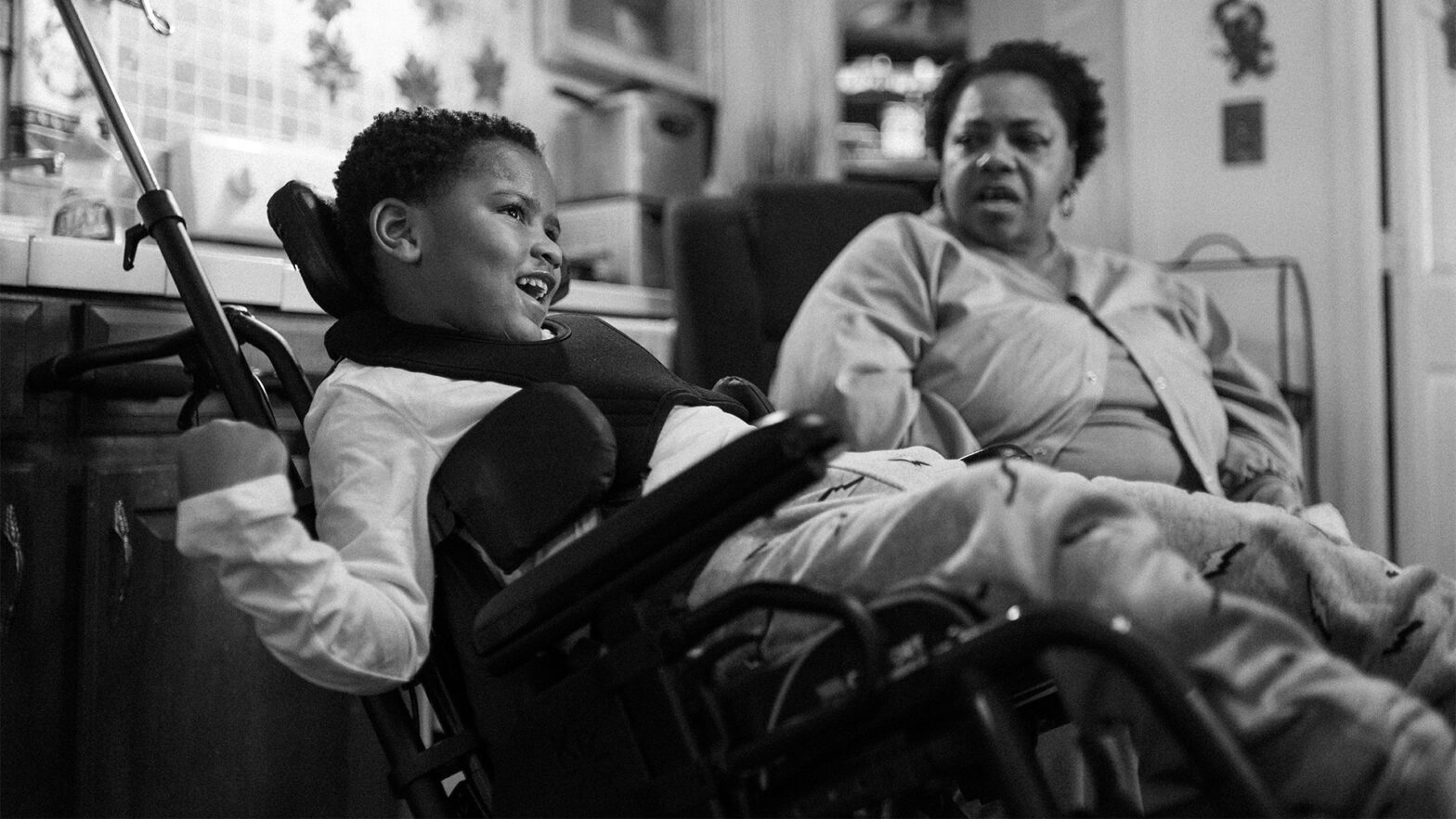Five-year-old Logan squirmed with delight when he heard the opening bars of his favorite music video, “I Love My Life” by Super Siah. Sitting beside him in her cozy kitchen, his grandmother, Coretta Johnson, discreetly wiped away tears.
The song had already captivated Logan well before last March. Before a car knocked him to the street, damaging his brain and leaving him in a wheelchair. Before he spent weeks at Children’s Hospital and months at Ranken Jordan Pediatric Bridge Hospital recovering and regaining strength. Before he moved into the spare bedroom at Ms. Johnson’s home, where the door is decorated with his beloved motorcycles and the floor is filled with medical lifts and other equipment.
“Everybody at Ranken Jordan knew this was his favorite song,” Ms. Johnson recalled. “He would go crazy when they played it.” When Logan first arrived, the staff hadn’t been sure about his prognosis because he wasn’t very responsive—but his grandmother was fiercely optimistic. “I knew he was in there.” And time proved her right. By the time he left, the social youngster with deep dimples was a favorite.
“He’s the same,” Ms. Johnson says with conviction. “He acts the same. He’s still a TV addict. He’s obsessed with cars and motorcycles. He laughs all day. He likes to go, go go!”
She paused, with “I Love My Life” still playing on the TV, Logan continuing to smile and move to the music. “I just want Logan to be happy,” she said.
One of the reasons Logan loved Super Siah was the precocious 10-year-old YouTube star’s upbeat attitude. In his videos, the young social media influencer and singer drives and dances around the neighborhood with friends, with cars prominently featured—and according to his grandmother, Logan adored anything related to vehicles.
Ms. Johnson pulled up a favorite video on her phone and pointed to then-4-year-old Logan speeding around a parking lot on a mini motorcycle, completely fearless and in control. She has a feeling he would be fascinated by his motorized wheelchair too, because “it literally comes apart like a Transformer,” she explained.
It’s especially ironic that Logan’s injuries were caused by a vehicle. On March 5, he was playing with a group of children on the street outside his home, showing off a new toy splatter ball gun, when an SUV approached. The other children scattered, but Logan wasn’t able to get out its path, and it knocked him to the ground. “Nothing was broken,” Ms. Johnson said. “He just hit his head.”
The deeply apologetic driver stayed in touch, even coming to visit Logan in the hospital.
Building the Ramp
As Logan’s recovery progressed and he prepared to leave Ranken Jordan, a nonprofit specialty pediatric hospital that provides treatment programs for children with complex medical conditions and injuries, there was a question about where he would live. He previously split his time between his mother’s home and Ms. Johnson’s, where he spent every other weekend.
When Ms. Johnson, his mother, and his maternal grandmother consulted over the best place for him to receive the care he needed, they decided that Ms. Johnson, with her training as a certified nursing assistant, would be the best caregiver.
“It’s not uncommon for home accessibility to be a huge barrier for families.”
But a formidable hurdle to Logan’s homecoming was getting his wheelchair into and out of his grandmother’s residence in Pagedale, said Sherry Mitchler, a social worker at Ranken Jordan. As part of their services, they start working with families on a discharge plan from the time of admission—because sometimes getting the plan in place can take many months, as it did in Logan’s case; he entered Ranken Jordan on May 15 and didn’t leave until November. “It’s not uncommon for home accessibility to be a huge barrier for families,” she explained.
The steep descent from the front porch to the street made installing a ramp there impossible. But Ms. Johnson knew the home, which she rents from Beyond Housing, also had a sealed-up back entrance. That proved to be key.
Initially, Beyond Housing offered Ms. Johnson the option of moving to another house. She declined. “I know all my neighbors,” she explained. “They’re great.” She had even been thinking about going through homeownership classes to start the process of buying the house. The Beyond Housing staff, knowing what an important role a sense of community plays in families’ well-being, did not press the issue.
Instead, the request for adding a ramp in the back made its way through Beyond Housing maintenance department. After the staff learned the details of her grandson’s situation, they told Ms. Johnson the project was a priority.
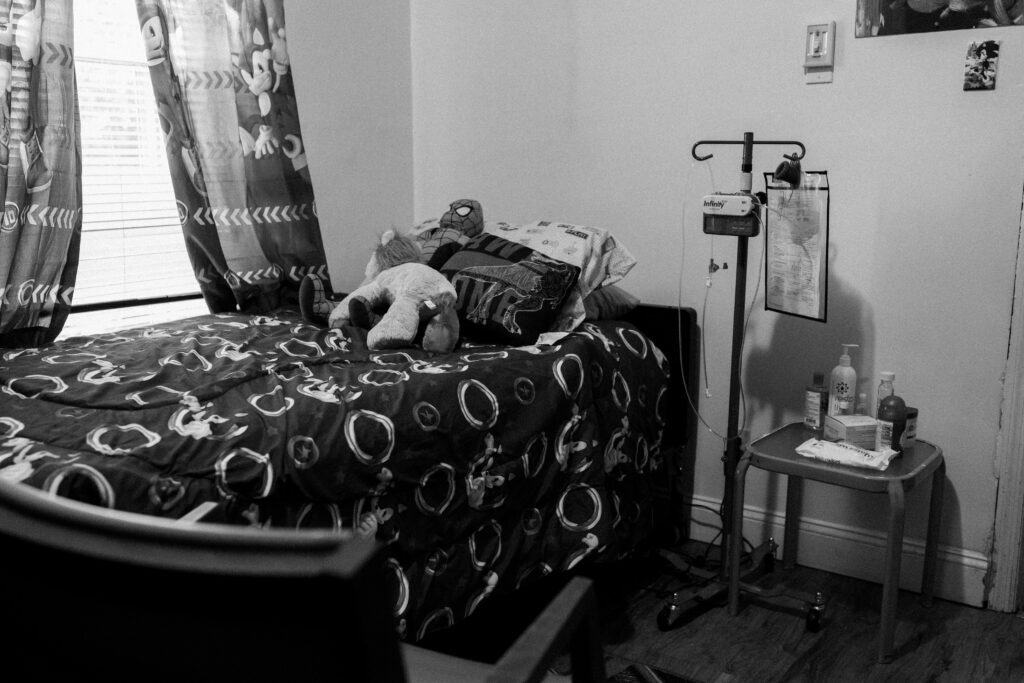
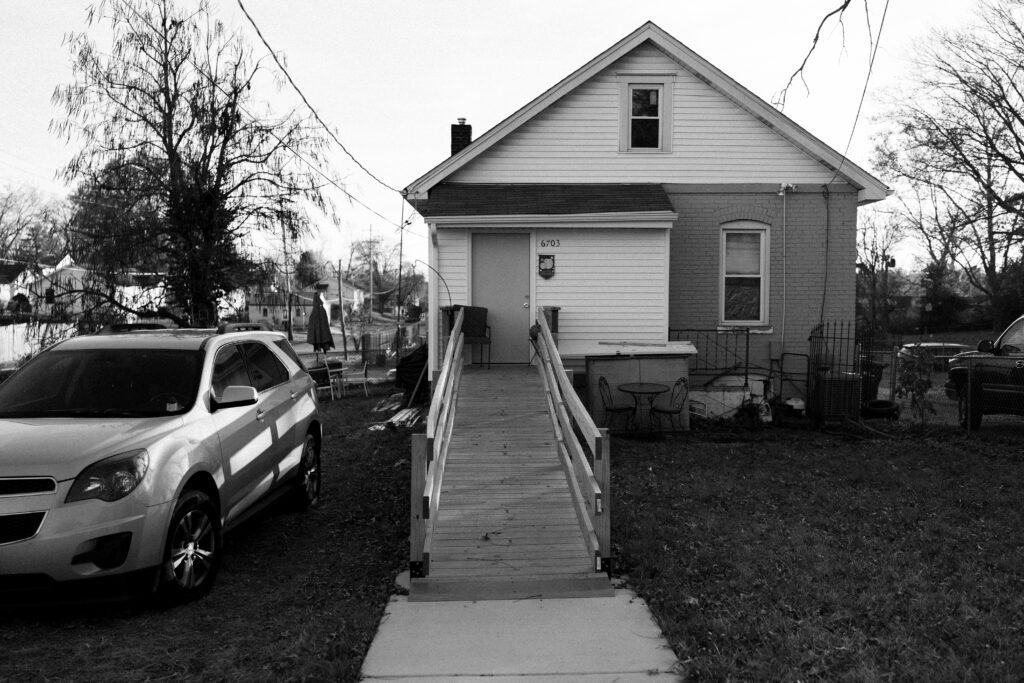
What happened next is a testament to the enormous community spirit of nearly a dozen nonprofits and local businesses who donated more than $10,000 in materials and labor to make sure Logan could get into and out of the house, both now and as he grows into bigger wheelchairs in the future.
Beyond Housing approached Joel Gardner, the Business Development Manager at Bingman Construction Company. “When I found out about this opportunity, I knew what all would go into it,” Gardner said. “I brought it to our President, Justin Bingman, and he loved the idea.”
Bingman, a general contractor that often works in the affordable housing and community development space, brought together industry partners to complete work that included:
- Renovating an addition that had been added to the back of the house and was being used as a closet.
- Removing the interior doorframe and some of the masonry wall to enlarge the doorway, then adding a new exterior doorframe and door.
- Removing flooring in order to flatten the thresholds for accessibility, then repairing the floors.
- Pouring a 5-foot-wide, ADA-compliant sidewalk from the back of the house to the alley.
- Building an exterior deck to which the ramp could be attached.
- Replacing the exterior siding and trim after the door was installed.
“When we took this on, Beyond Housing left it up to us how to make it happen,” Gardner said. “We bring in subcontractors to accomplish projects, and this one was no different.” Bingman collaborated with Next Level Construction on the concrete sidewalk; Square UP Builders, a subsidiary of The UP Companies, for the interior and exterior carpentry, demolition, and door and flooring installation; Allen Roofing & Siding for supplying siding and installing it after the door was in place; and Great Central Lumber & Millwork Co., which supplied all the materials for the carpentry portion including the construction of the deck and door; and Waste Connections to handle removal of the construction debris.
Once the plan for the house renovations was established, Mitchler was able to move forward with the final piece of the accessibility puzzle, a wheelchair ramp. She reached out to a longtime partner, Gateway Housing Service Project. “They’re such a wonderful resource for a lot of families, because a ramp is a huge necessity, and it’s something that is difficult to get funding for,” Mitchler said.
GHSP is a volunteer-led, donor-funded nonprofit that installs wheelchair ramps at no cost to the recipient, said Founder Darryl Stanfield, who started the organization six and a half years ago after learning of the severity of the accessibility problem. GHSP often works with families at Ranken Jordan, the Delta Center, and other local care providers who care for patients with mobility challenges.
“When I got into this, I liked building things and helping people, but I had no idea that the need for accessibility was as large as it is, and that the resources are very slim,” said Stanfield, whose full-time career is in the retail food business. “In most cases, insurance won’t fund any kind of ramp, although they will fund wheelchairs and power chairs.”
Over the years, Stanfield has become well versed in the various regulations and codes across GHSP’s service area, which is roughly a one-hour radius from St. Louis. The organization relies on the expertise of professors and students from Washington University’s occupational therapy department when questions about mobility arise, and it enlists between 10 and 12 volunteers on every ramp construction project.
Logan’s ramp was GHSP’s second project with LitShop, which pairs literacy activities with building and making projects for girls and gender-expansive youth ages 10 to 17.
“When they came, they said they didn’t want to disturb me,” Ms. Johnson said, thinking back to the day the volunteers from GHSP and LitShop started building the wooden ramp. Before she knew it, they knocked on the door and told her it was ready. “I looked out there, and those two men and eight girls had finished it!” she exclaimed. “They weren’t playing. They came to get it done.”
“I never imagined how well it would turn out,” Ms. Johnson added. “I didn’t know it was going to be so elaborate.”
From Stanfield’s perspective, the project would not have been possible without Beyond Housing coordinating the construction on the house as well as the concrete sidewalk, all of which is outside the scope of GHSP’s budget. “This project worked out really well,” Stanfield said. “It was the first time we’ve had four organizations involved—Beyond Housing, LitShop, Ranken Jordan, and GHSP—and we’re hoping to do more of that.”
“Beyond Housing is what the word says—they help you move further in your life.”
Ms. Johnson had lived in a Beyond Housing rental when her children were small, so she was familiar with the nonprofit’s holistic approach to community development. “Beyond Housing is what the word says—they help you move further in your life,” she said.
For this project, all the contractors were grateful to the support and coordination from Marcellus Speight, Beyond Housing’s Maintenance Superintendent, who secured city permits and scheduled all the various teammates. “He practically lived at Pagedale City Hall,” said Cory Dickens, Senior Director of Housing. “The project really took a village of partners and in-kind dollars to make happen, turning a tragedy into a happy ending for Ms. Johnson and Logan.”
The Homecoming
Two days before Thanksgiving, Logan was finally able to move into Ms. Johnson’s home. “Since coming home, he’s more relaxed,” she said. “He’s Logan again.”
Logan’s day-to-day routine starts early in the morning. “He doesn’t like to be in bed,” said his grandmother with a laugh. He loves the same things as most kindergarteners: books, TV shows, playing with toys, video calls with friends and family.
He’s once again trying to chew his fingernails—something Ms. Johnson playfully discourages, although she’s delighted that he is regaining more range of motion in his arms. He doesn’t exhibit any shyness around strangers, smiling easily and often, and he enjoys going outside with his family caregiver to greet his grandmother when she gets home from work every afternoon.
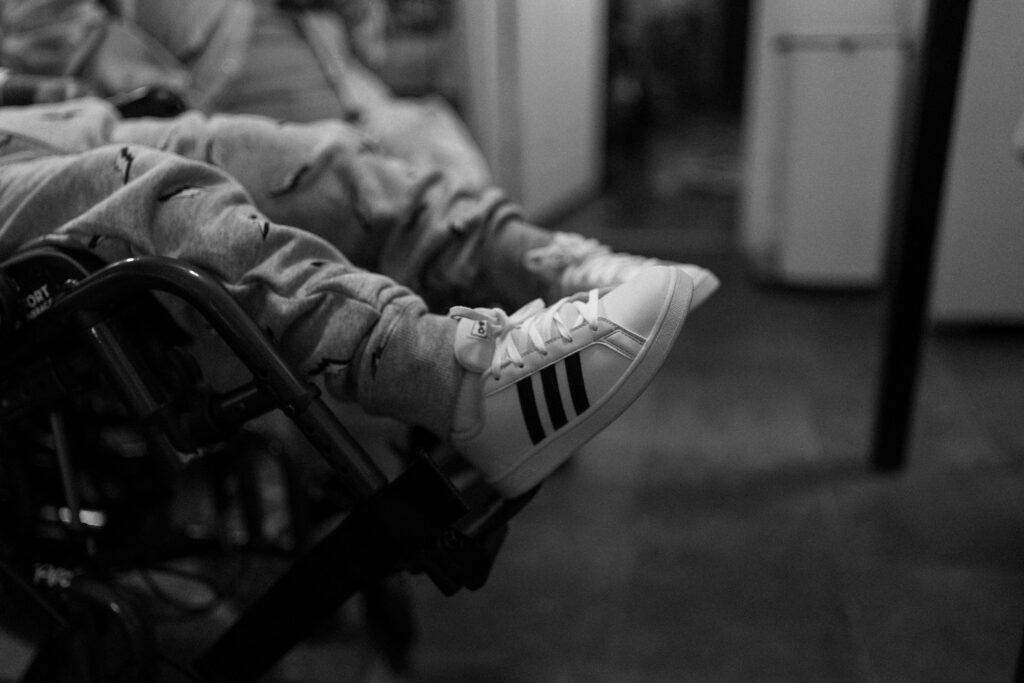
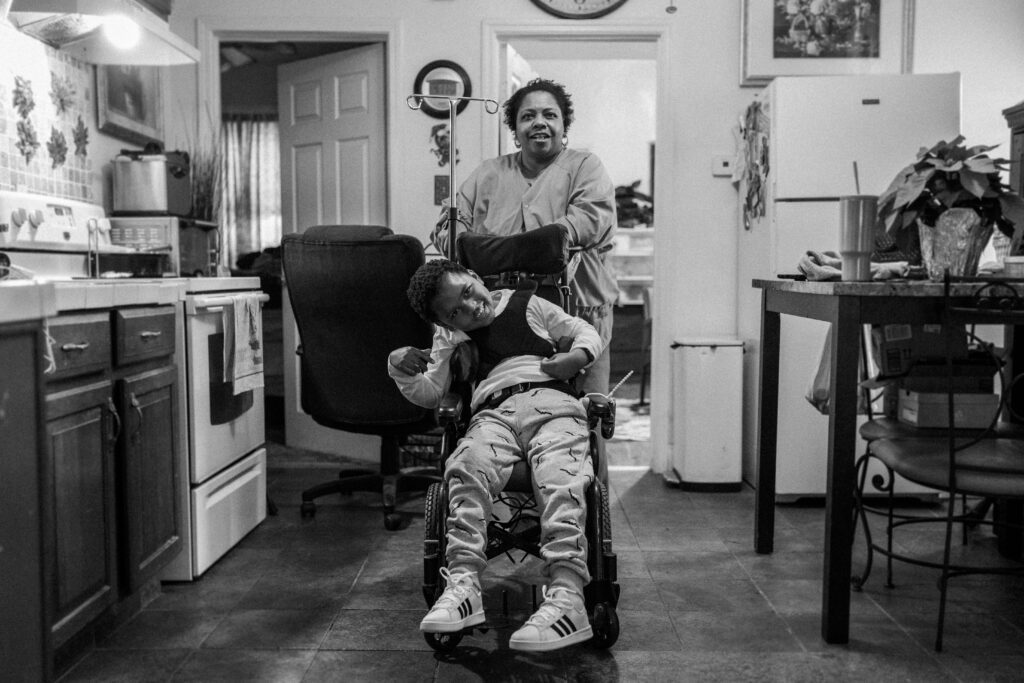
Like his YouTube influencer hero Super Siah, Logan likes to dress fashionably—something Ms. Johnson wholeheartedly encourages. “He’s so fly,” she said proudly, gesturing toward his pristine white tennis shoes and the rest of his sporty attire.
And although she’s clearly proud of her grandson’s progress, Ms. Johnson is realistic about the responsibilities she and other family members are taking on, including Logan’s 8-year-old sister, who she describes as his second mother because she’s so fiercely protective of him.
The Path Ahead
Ms. Johnson has had a series of meetings with the local Normandy School District as well as St. Louis County’s Special School District to develop an IEP for Logan and figure out the best educational setting for him. She’s receiving support in that process from MPACT, a nonprofit that empowers families to advocate for themselves so children with special education needs can reach their full potential.
A tenacious advocate, she chafes at any suggestion that Logan’s prognosis is limited. “Everything they said Logan wouldn’t do, he’s doing,” she said. “He was stiff as a board after the surgery, and they weren’t sure he would regain movement. They weren’t sure he was in there, and now he’s trying to talk. He’ll go to Ranken Jordan for speech therapy. He’ll learn to eat again.”
And when Ms. Johnson mentions his favorite food, crab legs, Logan perks up eagerly—clearly anticipating the day when he can ditch the liquid diet and start munching seafood.
“Logan is a fighter,” she said. “He’s very competitive.” She channels that spirit toward his rehabilitation, having him do sets of pump-ups in bed to strengthen his core and coaching him to say simple phrases like “I love you.” In that, he’s very much like his grandmother. When asked about the challenges ahead, including the IEP, she replied, “My name is Coretta for a reason. I’m going to get things done.”
